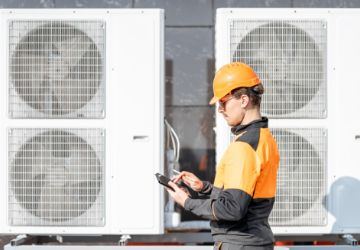Gas Engineers: Converting Your Skills to Air souce Heat Pumps
- February 22, 2024

As a gas engineer, you possess a valuable skill set that can be adapted to work with air source heat pumps. This guide will walk you through the basics of air source heat pumps, explore the career opportunities in this field, and provide insights on how to transition your gas engineering skills to work with air source heat pumps. Additionally, we'll discuss the necessary training and certification for this transition, address common challenges, and showcase success stories of gas engineers who have successfully made the switch. By the end of this guide, you'll have a comprehensive understanding of how to transfer your skills to air source heat pump installation.
Understanding the Basics of Air Source Heat Pumps
What Are Air Source Heat Pumps?
An air source heat pump (ASHP) is a renewable energy technology that extracts heat from the outside air and uses it to provide heating and hot water in residential and commercial buildings. This innovative system operates by absorbing heat from the outdoor air and transferring it into the building through a series of coils and a heat exchanger. ASHPs are highly efficient, environmentally friendly, and can provide both heating and cooling functions, making them a versatile choice for property owners.
How Do Air Source Heat Pumps Work?
Air source heat pumps work on the principle of refrigeration, using a refrigerant to absorb and release heat as it circulates through the system. The outdoor unit contains a fan that draws in air, and the refrigerant within the system absorbs the heat from the air. The heated refrigerant then passes through a compressor, increasing its temperature, before transferring the heat to the indoor unit. Finally, the indoor unit releases the heat into the building, providing warmth during colder months. In warmer weather, the process can be reversed to provide cooling.
Environmental Benefits of Air Source Heat Pumps
One of the key advantages of air source heat pumps is their environmental friendliness. By harnessing renewable energy from the air, ASHPs produce lower carbon emissions compared to traditional heating systems, contributing to a greener and more sustainable future. This eco-friendly aspect makes air source heat pumps an attractive choice for environmentally conscious consumers and aligns with global efforts to reduce carbon footprints.
Exploring the Career Opportunities in Air Source Heat Pump Installation
Growing Demand for Air Source Heat Pump Installers
The increasing awareness of environmental issues and the shift towards sustainable energy solutions have led to a rising demand for air source heat pump installation. As a gas engineer, you are well-positioned to capitalize on this growing market, leveraging your existing technical expertise to transition into the installation and maintenance of ASHP systems.
Diverse Job Opportunities
Transitioning to air source heat pump installation opens up diverse job opportunities within the renewable energy sector. From residential installations to commercial projects, there is a wide range of potential clients seeking ASHP solutions. Additionally, the ongoing maintenance and servicing of air source heat pump systems create a steady stream of work, providing long-term career prospects for skilled professionals.
Contributing to Sustainable Energy
By embracing air source heat pump installation, gas engineers can actively contribute to the promotion of sustainable energy practices. The transition presents an opportunity to be part of a movement towards cleaner and more efficient heating solutions, making a positive impact on both the environment and the communities served.
Adapting Your Gas Engineering Skills to Work with Air Source Heat Pumps
Technical Knowledge Transfer
Many of the technical skills and knowledge acquired as a gas engineer can be seamlessly transferred to working with air source heat pumps. Understanding of heating systems, pipework installation, and electrical components are all relevant to ASHP installation, providing a solid foundation for the transition.
Embracing New Technologies
While there are similarities between gas heating systems and air source heat pumps, it's crucial to familiarize yourself with the specific components and operation of ASHPs. This may involve learning about refrigeration cycles, heat exchangers, and the integration of smart controls, all of which contribute to the efficient functioning of air source heat pump systems.
Customer Service and Communication
As a gas engineer, you likely have experience in engaging with clients and providing excellent customer service. These interpersonal skills are equally valuable in the context of air source heat pump installation, as you interact with property owners, offering guidance and ensuring their understanding of the benefits of ASHP technology.
Training and Certification for Transitioning to Air Source Heat Pump Installation
Recognized Training Programs
To successfully transition from gas engineering to air source heat pump installation, it's essential to undergo specialized training programs that focus on the design, installation, and maintenance of ASHP systems. Look for accredited courses that provide comprehensive instruction in ASHP technology, system sizing, and regulatory requirements.
Industry-Standard Certifications
Obtaining industry-recognized certifications in air source heat pump installation demonstrates your commitment to professional development and assures clients of your expertise in the field. These certifications validate your skills and knowledge, enhancing your credibility as an ASHP installer and opening doors to a wider range of opportunities.
Continuous Learning and Skill Enhancement
In the rapidly evolving landscape of renewable energy technologies, ongoing learning and skill enhancement are crucial. Stay updated with the latest advancements in air source heat pump technology, industry best practices, and regulatory changes, positioning yourself as a knowledgeable and adaptable professional in the field.
Overcoming Challenges When Switching from Gas Engineering to Air Source Heat Pumps
Regulatory Compliance
Navigating the regulatory landscape associated with air source heat pump installation requires a thorough understanding of building codes, environmental regulations, and industry standards. Familiarize yourself with the legal requirements and ensure full compliance when transitioning to ASHP work.
Equipment and Tooling
Transitioning to air source heat pump installation may necessitate acquiring new equipment and specialized tools tailored to the requirements of ASHP systems. Assess the necessary investments and consider the procurement of essential tools and instruments to facilitate efficient installation and servicing.
Building a Reputation in a New Field
Establishing credibility and building a reputation in the air source heat pump sector can pose initial challenges. Leverage your existing network, demonstrate your expertise through successful installations, and prioritize customer satisfaction to build a strong presence in the ASHP market.
Success Stories: Gas Engineers Who Have Successfully Transitioned to Air Source Heat Pump Installation
Case Studies of Seamless Transitions
Numerous gas engineers have made successful transitions to air source heat pump installation, leveraging their technical acumen and dedication to excellence. By undergoing specialized training, obtaining relevant certifications, and embracing the opportunities presented by renewable energy, these professionals have seamlessly integrated ASHP work into their service offerings.
Client Testimonials and Satisfaction
The transition to air source heat pump installation has not only expanded the scope of services for gas engineers but has also garnered positive feedback from satisfied clients. By delivering high-quality installations and reliable maintenance, these professionals have established themselves as trusted providers of ASHP solutions, earning praise and loyalty from property owners.
Navigating Career Growth
The stories of gas engineers who have transitioned to air source heat pump installation serve as inspiring examples of career growth and adaptability. Their experiences highlight the potential for professional advancement, the fulfillment of contributing to sustainable energy practices, and the rewarding nature of embracing new opportunities within the renewable energy sector.
In conclusion, the transition from gas engineering to air source heat pump installation presents a wealth of opportunities for skilled professionals. By understanding the fundamentals of ASHP technology, embracing specialized training, and leveraging existing expertise, gas engineers can seamlessly adapt their skills to meet the growing demand for sustainable heating solutions. The journey may present challenges, but with dedication, continuous learning, and a commitment to excellence, the transition to air source heat pump installation can lead to a rewarding and impactful career path.
Remember, the journey from gas engineering to air source heat pump installation is an evolution that aligns with the changing landscape of energy solutions. Embrace the transition, stay informed, and seize the potential for growth and contribution in the renewable energy sector.


